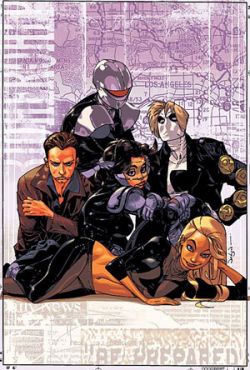The Loners #1
By Al Kratina
April 19, 2007 - 22:40
Marvel Comics
Writer(s): C.B. Cebulski
Penciller(s): Karl Moline
Colourist(s): Christina Strain
Letterer(s): Rus Wooton

The Loner #1 of 5

Comic books have grown up a lot lately. That’s not to say that they’ve matured, really, as they still mainly deal with people dressed like armored Liberaches pretending to be the Lone Ranger, but they’re starting to address more mature concepts. Essentially, comic books are The 40 Year Old Virgin in the last act, still childish, but forced to deal with adult issues.
And that’s what The Loners is all about; the maturation of a childish concept. Spun off from a Runaways story-line, The Loners deals with a self-help group for superheroes, in which costumed vigilantes trying to give up the life of masked heroism meet to battle their more figurative demons. It’s an inherently hilarious concept, one that would be right at home in a story arc from Powers, but in Loners, it doesn’t really live up to its full potential. The group, sponsored by perennial sidekick Rick Jones, is comprised of Turbo, the good Green Goblin, Ricochet, Darkhawk, one of the Spider Women, and Lightspeed. The scenes within the actual self-help group have so much potential for comedy, drama, and tragedy, and often seem on the verge of carrying the entire comic, such as Lightspeed’s child star complex. But all too quickly, writer C.B. Cebulski lets things degenerate into a standard superhero comic. Admittedly, the idea of a recovering superhero relapsing back into crimefighting is funny, but once Darkhawk, Richochet, and whichever Spider-Woman this happens to be suit up again and start fighting Mutant Growth Hormone traffickers, all the originality seeps out of the story. Nevertheless, despite the flaws, there’s a lot of potential in the series.
As the writing is most exciting in the support group scenes, so, strangely, is the art. Perhaps fearing that a group of characters sitting around talking would be stagnant, artist Karl Moline puts a great deal of energy into dynamic perspectives and backgrounds. Some of the panels, primarily a sequence in which Lightspeed confronts the rest of the group, manage to make the mundane visually captivating, like dropping acid in Canadian History class and watching the pre-Confederation territories dance. When the inevitable battle fills out the last few pages, the originality leaves the art, though the action scenes are never dull. In 22 short pages, both Moline and Cebulski show us what they’re capable of, but also show us the flipside. It remains to be seen whether the rest of the series will live up to the promise glimpsed in the first few pages, or simply revert back to adolescence.
Rating: 6 on 10
